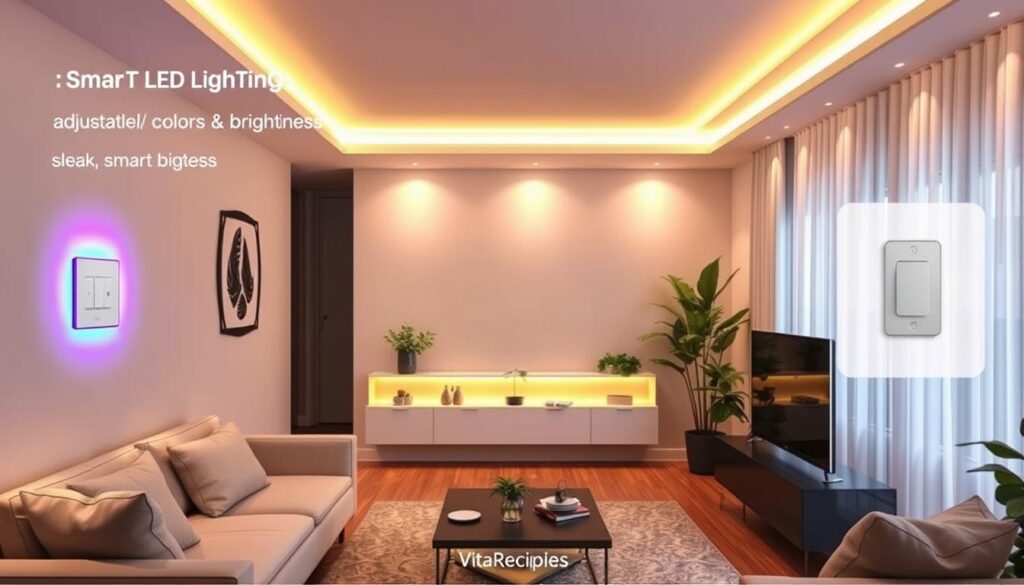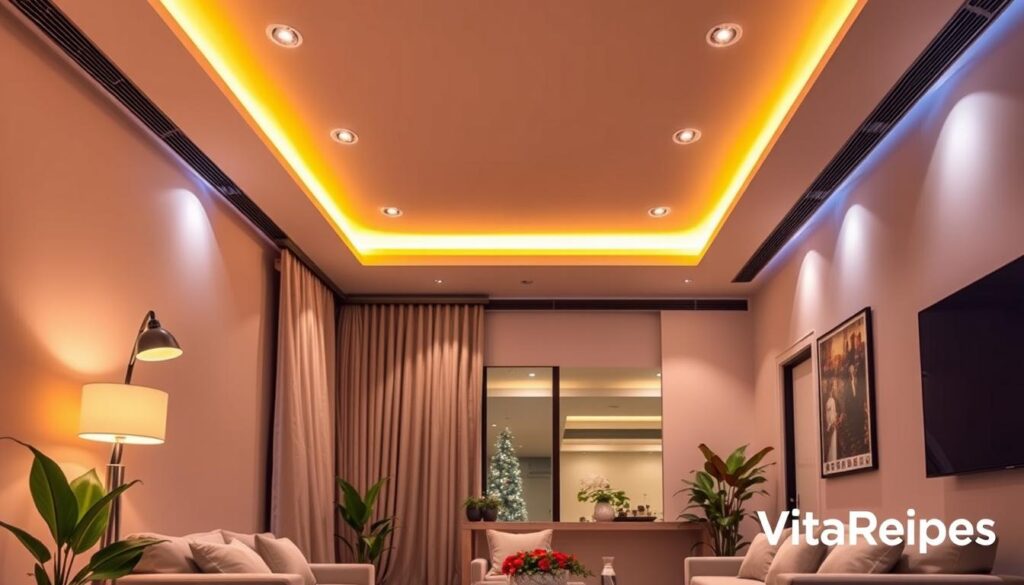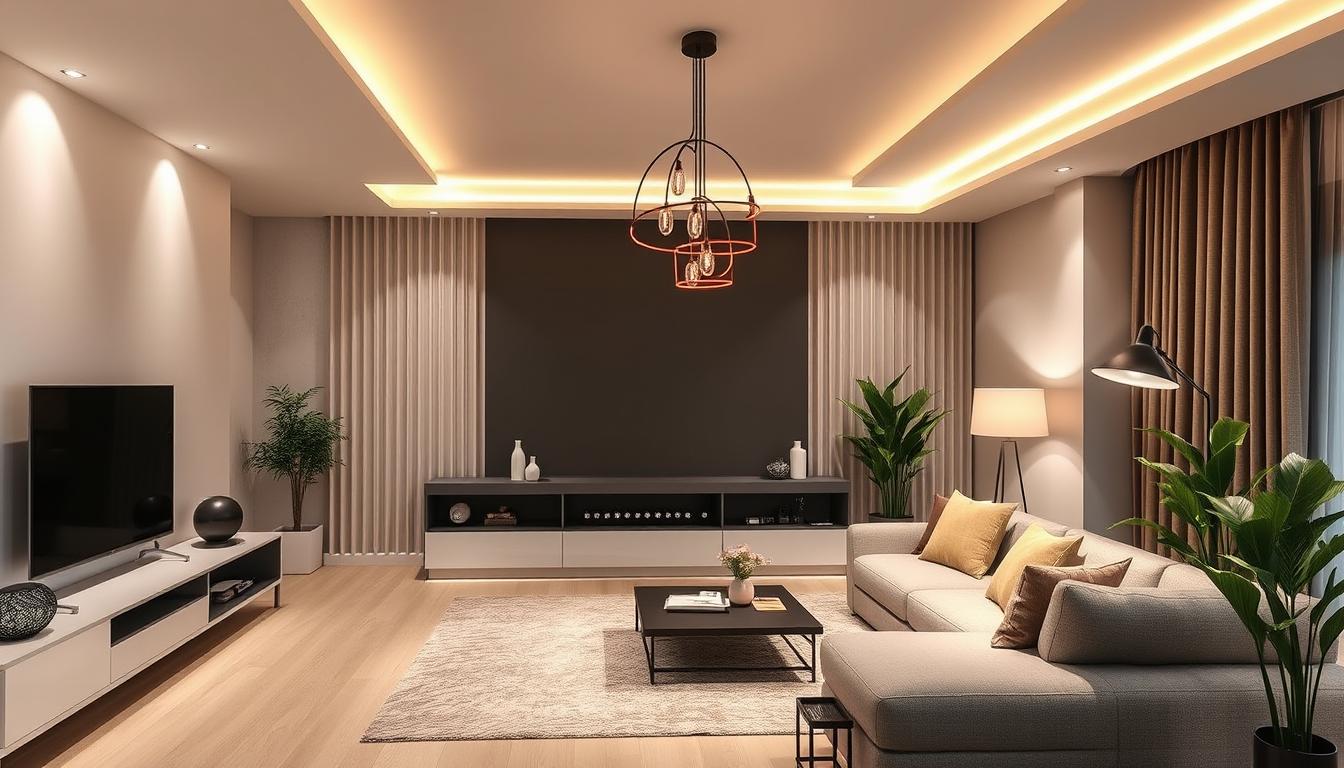Choosing the right lighting system is key for your home’s look and function. It makes your home feel welcoming, easier to use, and can even boost your mood and health. The global smart lighting market was worth $15.05 billion in 2022 and is growing fast, with a 22.1% annual growth rate expected by 2030. This guide will walk you through different lighting choices, from old-school to cutting-edge smart options, to make every room in your home perfect.
Key Takeaways
- Lighting is essential for creating the right ambiance and functionality in your home.
- The global smart lighting market is experiencing rapid growth, with a projected CAGR of 22.1% through 2030.
- This guide will help you explore a range of lighting options, from traditional to modern smart solutions.
- Choosing the right lighting system can enhance your home’s aesthetics, improve energy efficiency, and integrate with smart home technologies.
- Evaluating your lighting needs, considering your personal style, and understanding the latest trends will ensure you select the perfect lighting system for your home.
Understanding the Importance of a Good Lighting System
A good lighting controls system can change how your residential lighting looks and works. The right indoor lighting can make rooms look bigger, show off the design, and even change how you feel. Mixing ambient, task, and accent lighting creates a balanced scheme for all parts of your home.
Enhancing Aesthetics and Ambiance
Lighting is key in setting the mood and feel of your home. A well-thought-out lighting plan can highlight your home’s design, making it look great and welcoming. The right lights can make a room feel bigger, cozier, or even more dramatic, based on what you like.
Improving Functionality in Your Spaces
Good lighting controls also make your home more useful. Task lighting in work areas boosts productivity and cuts down eye strain. Ambient lighting helps you relax and feel good. Bright lights during the day keep you alert, while soft lights at night help you sleep better.
“Lighting plays a critical role in projects, affecting aesthetics, functionality, safety, sustainability, and overall space experience.”
Whether you want a cozy feel or better use of your space, a well-designed residential lighting system can greatly improve your home’s vibe and usefulness.
Types of Lighting Systems for Your Home
Creating the perfect lighting design for your residential lighting needs is key. It’s about understanding the different types of lighting systems. They work together to change your home’s look and feel.
Ambient Lighting
Ambient lighting makes a space feel welcoming and bright. It’s often found in recessed lights, floor lamps, or surface-mounted fixtures. Living rooms, bedrooms, and hallways are great places for it.
Task Lighting
Task lighting focuses on specific activities, like reading or cooking. It’s found in sconces, pendants, chandeliers, and task lamps. These lights make work areas like home offices and kitchens better.
Accent Lighting
Accent lighting draws attention to special features or artwork. Low-output fixtures like picture lights or track lighting are perfect. They add depth and interest to your residential lighting.
By using these three types of lighting, you can make your indoor lighting system balanced and beautiful. It will improve both the look and function of your home.
“Lighting has the ability to completely transform a space, setting the mood and highlighting the key architectural features.”
When designing your home’s lighting, mix different styles. Use elegant, simple, and ornate fixtures for interest. Avoid too many recessed lights. Instead, choose fixtures that are decorative.
| Lighting Type | Purpose | Examples |
|---|---|---|
| Ambient Lighting | Overall illumination | Recessed lights, floor lamps, surface-mounted fixtures |
| Task Lighting | Focused illumination for specific activities | Sconces, pendants, chandeliers, task lamps |
| Accent Lighting | Highlighting architectural features or decor | Picture lights, track lighting |
Key Features to Consider in a Lighting System
Choosing the right lighting system for your home is crucial. Look for features like energy efficiency, smart home compatibility, and customization options. These aspects can make your lighting system more functional, cost-effective, and tailored to your needs.
Energy Efficiency
Opt for energy-efficient lighting, especially LED bulbs. They use up to 80% less energy than old bulbs and last much longer. Make sure to pick Energy Star certified products for the best energy-saving performance.
Smart Home Compatibility
Smart lighting systems bring a new level of convenience. You can change brightness, color, and schedules with apps or voice commands. They work well with your smart home, making your life easier and more efficient.
Customization Options
Choose a lighting system that lets you customize. Options like dimmable lights and color-changing bulbs let you set the mood. Whether it’s for a dinner party or a relaxing evening, you can create the perfect atmosphere.
| Feature | Benefit |
|---|---|
| Energy Efficiency | Reduces energy consumption and utility costs |
| Smart Home Compatibility | Offers convenience and control through apps and voice commands |
| Customization Options | Enables personalized lighting to suit any mood or occasion |
By focusing on these key features, you can make your home lighting system better. It will not only look great and work well but also save energy, be easy to use, and fit your personal style.
How to Assess Your Lighting Needs
Figuring out your lighting needs is key to a perfect home lighting system. Look at each room’s purpose, think about your lifestyle, and consider your style. This way, you can create a lighting plan that looks good and works well for you.
Evaluating Each Room
Begin by looking at what each room needs. Living rooms and bedrooms need soft, ambient light with 1,500-3,000 lumens. Kitchens and bathrooms need brighter task lighting, around 3,000-4,000 lumens. Think about the room’s size, layout, and what happens there to pick the right lighting.
Considering Your Lifestyle
Your daily life affects your lighting needs. You might want smart lights that change brightness like the sun. This can help your body adjust to day and night, improving sleep.
Personal Style and Preferences
Your personal taste shapes your lighting choices. Whether you like traditional or modern, or simple or bold, your style guides your lighting picks. This ensures your home’s lighting fits your unique taste.
By carefully looking at each room, thinking about your lifestyle, and considering your style, you can craft a lighting design that boosts your residential lighting and indoor lighting. It will also show off your personal needs and tastes.
Choosing Between Traditional and Modern Lighting
When picking the right lighting for your home, you can go for traditional or modern options. Each has its own perks, fitting different tastes and needs.
Benefits of Traditional Fixtures
Traditional lights, like chandeliers and ornate sconces, bring elegance and timeless beauty. They’re perfect for classic or formal homes. These lights make rooms like the dining or living area feel cozy and welcoming.
Advantages of Modern Solutions
Modern lights, including recessed and LED fixtures, have many benefits. They’re often energy-saving, customizable, and smart home-friendly. Smart lighting lets you set schedules, change brightness, and create scenes for different moods or tasks.
Think about your home’s style and what you need when choosing between traditional and modern lights. Traditional lighting suits classic interiors, while modern lighting offers efficiency and tech for commercial lighting or residential lighting.
The Role of Smart Technology in Lighting
Smart lighting has changed how we light our homes. It brings convenience and control. With systems like Philips Hue, you can make custom lighting scenes and control lights from your phone.
Smart lighting works well with other smart devices. This makes your home more functional and cozy.
Convenience and Control
Smart lighting lets you change the brightness and color of your home’s lights easily. It’s great for movie nights or when you come home. You can use smart switches or apps to control your lights.
Integration with Home Automation
Smart lighting works with your home’s automation. It lets you control your home better. For example, lights can turn on when you arrive or when you move around.
This makes your home more convenient and saves energy. It’s part of the smart home revolution.
Smart lighting has made our homes better. It adds convenience, ambiance, and helps save energy. By using smart lighting, you make your home more efficient and enjoyable.

| Feature | Traditional Lighting | Smart Lighting |
|---|---|---|
| Convenience | Manual controls, limited customization | Remote control, scheduling, voice commands |
| Ambiance | Fixed brightness and color | Adjustable brightness, color, and mood settings |
| Energy Efficiency | Higher energy consumption | Automatic dimming, occupancy detection, scheduling |
| Integration | Standalone lighting fixtures | Seamless integration with home automation systems |
Energy-Efficient Lighting Options
Lighting your home should focus on energy efficiency. LED lighting is a top choice for saving energy and money. LEDs use up to 90% less energy than old bulbs and last up to 25,000 hours or more.
LEDs offer a wide range of colors, from warm whites to cool hues. This lets you set the mood in any room. Plus, they help cut down your energy bills and carbon footprint.
LED vs. Incandescent
- LED bulbs use up to 90% less energy than traditional incandescent bulbs.
- LEDs have a lifespan of up to 25,000 hours or more, outlasting incandescent bulbs by a significant margin.
- Incandescent bulbs convert only 10% of their electricity into visible light, with the rest being wasted as heat.
Solar-Powered Solutions
Solar-powered lights are great for outdoor areas. They use sunlight to light up your garden, paths, and patios. This way, you save on electricity and help the planet.
| Lighting Type | Energy Consumption | Annual Cost | Lifespan |
|---|---|---|---|
| Incandescent | 60W | $8.00 | 1,000 hours |
| Halogen | 42W | $5.60 | 2,000 hours |
| CFL | 14W | $1.90 | 8,000 hours |
| LED | 8W | $1.25 | 25,000 hours |
Choosing LED lighting and solar-powered solutions makes your home greener and cheaper. It improves your living spaces and the planet.
Budgeting for Your Lighting System
When planning your home lighting system, think about both the upfront costs and long-term savings. LED lights might cost more at first, but they save money over time. This is because they use less energy and last longer.
Understanding Costs
To make a good budget, consider the cost of fixtures, bulbs, and installation. Remember to look for rebates or incentives from your local government or utility company. These can help lower the initial cost.
Balancing Quality and Affordability
For commercial lighting or energy-efficient lighting in your home, find a balance between quality and price. Spend more on fixtures for rooms you use a lot, but save on less seen areas. Choose brands with good warranties and customer support for a long-lasting lighting system.
Understanding costs and prioritizing your needs helps you make a budget that works for your home and wallet. This way, you get a smooth and energy-saving lighting solution.
| Lighting Type | Energy Savings | Lifespan |
|---|---|---|
| LED | Up to 75-80% less energy than incandescent | 50,000 – 100,000 hours |
| Incandescent | N/A | 1,000 – 2,000 hours |
| Halogen | Up to 65% less energy than incandescent | 2,000 – 4,000 hours |
Installing Your Lighting System
When it’s time to install your new lighting system, you have two choices. You can do it yourself or hire a professional. For simple tasks like changing light bulbs, DIY is a good option. But for complex wiring or installing ceiling fixtures, a pro is better.
Professional Installation vs. DIY
If you’re good with electrical stuff and know the local codes, you might install it yourself. Just remember to turn off the power before starting. For places like bathrooms or outdoors, pick fixtures that can handle water.
But for big commercial lighting or residential lighting jobs, like rewiring, get a pro. They have the skills and tools to do it right and safely.
Important Safety Considerations
- Turn off power at the circuit breaker before working on any electrical components.
- Use fixtures with appropriate IP ratings for wet locations like bathrooms and outdoor areas.
- Follow manufacturer instructions and local building codes to ensure safe and compliant installations.
- Junction boxes typically hold up to 50 pounds when hanging a light fixture.
- Have one person support the weight of the existing fixture while the other unbolts any screws and lock nuts when removing it.
By being careful and knowing when to ask for help, you can make sure your lighting system is installed right. Whether you do it yourself or hire someone, safety is key.

Maintenance Tips for Your Lighting System
Keeping your home’s lighting system in top shape is key. It ensures your lights work well, save energy, and last longer. Cleaning and updating your lights can greatly improve their look and function.
Cleaning Fixtures and Bulbs
Cleaning your lights and bulbs regularly boosts their brightness and efficiency. For LED lights, just a quick dusting is needed. Watch for any changes in color or brightness, and replace bulbs that dim or change color.
Regular Upgrades
Technology keeps improving, so think about swapping out old lights for energy-efficient lighting like LED lighting. This can save a lot of energy and make your lights work better. It lets you enjoy the newest lighting system designs.
For smart lighting systems, make sure the software and apps are current. This ensures you get the latest features and security updates. Keeping your lighting system updated improves its performance and adds new features.
| Lighting System Type | Common Maintenance Tasks | Recommended Frequency |
|---|---|---|
| Incandescent | Check for burnt-out bulbs, clean fixtures | Annually |
| Fluorescent | Inspect ballasts, clean fixtures, replace bulbs | Annually |
| LED | Dust fixtures, check for color consistency, replace bulbs | Annually |
| HID | Check ballasts, clean fixtures, replace bulbs | Annually |
By following these tips, your home’s lighting system will keep working great. It will provide the right mood and save energy for many years.
Trends in Home Lighting Design
Home lighting is changing fast, with new trends making homes look and feel better. Homeowners are now choosing from many styles, from simple to bold. These changes in lighting design, indoor lighting, and residential lighting help make homes more welcoming and useful.
Minimalist Approaches
Minimalist lighting is all about simplicity. It uses LED strip lights and recessed lighting for a soft glow. This style lets the home’s design shine, keeping things clean and simple.
Bold and Creative Ideas
But there’s also a trend for bold, eye-catching lighting. Big pendant lights and unique chandeliers are in. Smart bulbs that change color add to the fun. Natural materials like wood and stone are also being used in lighting.
Smart technology is also big in lighting now. It lets you control lights with ease. You can change colors, brightness, and even set scenes. It’s all about making lighting easy and fun.
Home lighting is always changing, giving homeowners lots of choices. Whether you like simple or bold, there’s something for everyone. The latest in lighting design, indoor lighting, and residential lighting can make any home warm and inviting.
Making Your Final Decision
As you get close to choosing the perfect home lighting system, think carefully about your options. Look at energy efficiency, smart features, design, and long-term costs. Make sure your choice fits your home’s style, your lifestyle, and your budget.
Weighing Your Options
There are 22 types of lighting systems used in homes. It’s important to look at each one closely. LED lighting is popular for its energy savings, with 75% of homeowners choosing it.
45% of new homeowners want smart lighting systems. Interior designers recommend specific lighting for the best home decor, with 60% of them doing so.
Trusting Your Instincts
Expert advice is helpful, but trust your gut too. The Traffic Light system can guide you, with red, yellow, and green options. Your home’s lighting should improve its look, function, and energy use for years.

